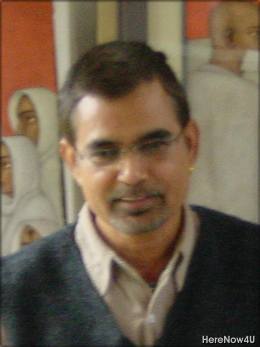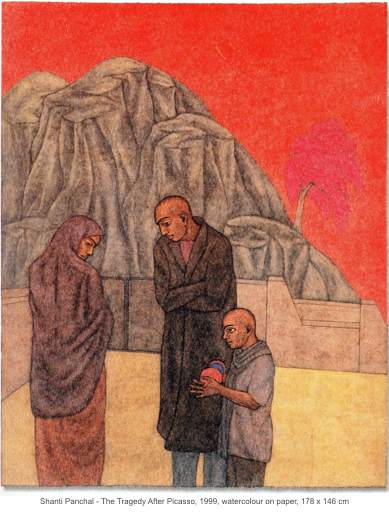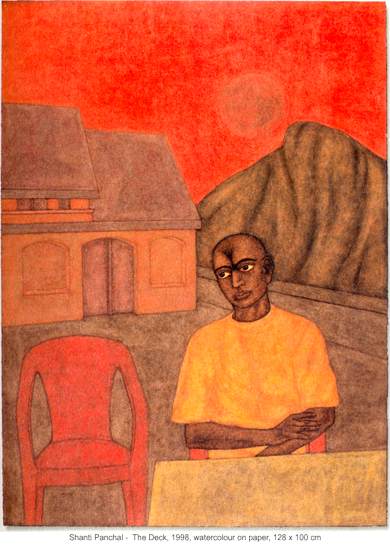
Kamala Kapoor on
Shanti Panchal
The artist Shanti Panchal, born and brought up in rural Mesar, near Patan in Gujarat, has lived and painted in London since 1978. He studied at the J.J. School of Art, Bombay and the Byam Shaw School of Art, London. Qualified to tackle the complex sensibilities of a life lived between two cultures, and to look beyond their immediate, seductive compulsions, Panchal has consistently stayed with his own best instincts. The result over the years has been a sentient presentation of the migrant experience with all it's sense of alienation and de-racination as well as of "imaginary homelands" (Salman Rushdie) re-invented from memory and desire.
Since his very first show at the Jehangir Art Gallery, Bombay, also in 1978, he has focused on the human figure along with the sparer concomitants of nature, architecture and assorted objects. Refined over the years, his medium, method and expression have been constantly evolving. Simplicity, careful placement, particularity of technique and reigned in yet evocative colours have lent his works both their elegant classic edge and their reflective mood.
For Panchal it has been watercolours on paper almost all the way. Starting with a small format in the early years - due to a shortage of studio space - he has turned more and more to larger sizes, some stretching to an imposing scale. His paper too has become thicker: 600 grams weight Arches paper (almost as thick as leather) is a favourite. The painter mixes colour on the paper itself, using a flat oil painting brush, removing, re-mixing and blotting as he goes along. "A great deal of saturation thus takes place", says Panchal who builds his layered depths - often as many as 12 deep - in the manner of a meditative exercise. "Only this paper can take this kind of hammering", adds the artist who creates atmospheres of veiled luminosity to produce his fresco-like physical surfaces.
Panchal's narratives are as if condensed into contained bodies of colour; the medium itself becomes as if a subtle form of intimacy, an integration into the painting of the artist himself. An instant of self-realization surfaces through the materiality of the paint and its transformations of pure shades of colour. All the blues, greys, reds and fuchsias of his palette, and his timeless figures, anecdotally legible only at the edges, enable the painter to achieve a moment of identity with his subjects and materials.
Shanti_Panchal_The_Tragedy_After_Picasso__1999__watercolour_on_paper__178_x_146_cm.jpg
While his early works were more about reminiscence and nostalgia, his more recent ones are about his responses to everyday living and to events that move him profoundly. The Tragedy After Picasso, is based on the experience of losing a good friend; each figure in the painting is shrouded in overwhelming grief, each one is isolated in private mourning. Based on the palpable sorrow of Picasso's The Tragedy - from his Blue Period -
Panchal invests even the mountain and tree in the background with a sense of imminent "collapse".
As an "exile", his stories cannot but recount his individual experiences in a remembering of the past that arises from his need to locate himself in the present. His enigmatic scenes frozen against flat surfaces carry an allusive charge. His enduring figures are situated in austere landscapes, their faces, portrait studies of personal loneliness and loss, are at the same time representations of the kind of emotional disquiet and questioning that pervades a great deal of the 20th century migratory psyche. His spare scenarios hone into anxious interior states. What is projected is a resonant silence, an otherworldly existence that has internalized personal and geo-political anxieties. What is reflected is an aura of psychic and philosophical calm viewed as if under a vast spread of moonlight.
"The fact of water colour as a medium and of autobiographical, narrative painting, finds favour in England: the galleries and museums are open to it" says the artist who admits that it took time for him to find his place in the art world. "To locate a personal visual language, it is important to be steadfast", maintains Panchal, whose art reaches out beyond current art world obsession with semiotic and conceptual game playing, to return again and again to the impacted sublimity of feeling. His painting field knows other potentials and limits than just that of message and polemic. The restraint inherent in his compositions, the asceticism of his images, the reserve of his subjects creates a reverberation as if below the threshold of hearing, projecting a life - no less compelling lived subliminally or as if in dreams and memory.
Goethe once wrote of his fascination with Sicilian landscape, culture, light and sense of time. In Panchal's case his lost paradise is Gujarat. There is no attempt at literal resuscitation however: its topographical and cultural essence is caught in the abstract. The paintings confront the viewer with heroic presences that make for a timeless vocabulary, weaving together the past and present. Like the paintings of the past, he builds his narratives on the morphology of the human figure and face, the impress of a posture, a look, a gesture immobilized as if symbolically or in private ritual. The familiarity of the male protagonist's shaven heads recall Jain mendicants. At the art historical level, the flattened picture plane, the significance of delineation, the elongated fish-shaped eyes, the proliferation of reds and blues, and the use of the watercolour medium go back to miniature painting traditions, particularly those of Jain manuscript paintings. At the mystical level, the mysterious, darkening V between the brows becomes synonymous with theVaishnav tilak, Shiva's third eye and the focal point of meditation.
Shanti_Panchal_The_Deck__1998__watercolour_on_paper__128_x_100_cm.jpg
Observations like these could be said to culminate in a haunting work like The Deck, where a priestly looking man appears to be awaiting an arrival or a happening, even as his anxious far away look portends a let down, possibly a betrayal. The dark moon, the ochre vestments the flare of red sky all have symbolic permutations. The cryptic scene can be taken at its enigmatic face value or as a contemplation of human isolation. Buried under the work's materiality could be mythological allusions in the sense of the eternal recurrence of meaning and truth.[1] "In the imaginative rhizome of human life, the symbol is an essential and fluid encapsulation of karma, the law of action and re-action which propels evolution."
Works like these incorporate a resonant silence. Serene yet disturbing, Panchal's paintings are shadowed as if by a historical scrim through which his protagonists assume their spiritual realization even as they appear to face their own mute predicaments. Bound by the perception of reality that can only be subjective, they seem forever poised on the brink of discovery and danger, of cultural difference and cultural diversity. Never overt, always subtle, these works address his people's symbolic and affective sources of identity in the midst of prevailing power structures. Theirs are "strategies of selfhood" (Homi Bhabha) within a renascent re-connecting to a culture and tradition that runs deep in the blood and imagination.
September, 2003[1] Alistair Shearer, pg: 23, The Hindu Vision, Thames and Hudson, 1993

